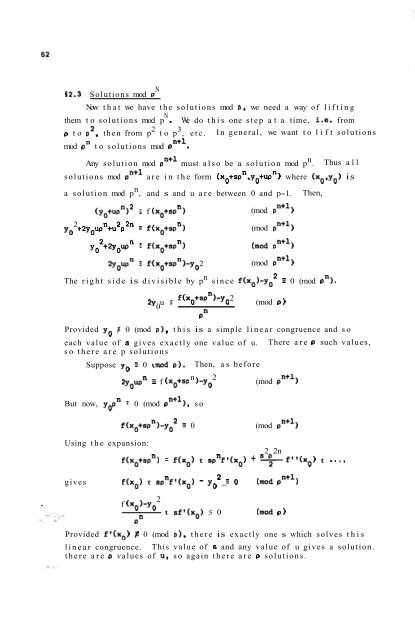You also want an ePaper? Increase the reach of your titles
YUMPU automatically turns print PDFs into web optimized ePapers that Google loves.
52.3 Solutions mod p N<strong>No</strong>w that we have the solutions mod p, we need a way of liftingNthem to solutions mod p . We do this one step at a time, i.e. fromp to p2, then from p 2 to p 3 , etc.nt1mod pn to solutions mod p .In general, we want to lift solutionsAny solution mod p n must also be a solution mod p n .solutions mod pntlThus allare in the form (xotspn,yo+upn) where (xo.yo) isa solution mod p n , and s and u are between 0 and p-1.(y+u~")~ 2 f (x0tspn) (mod pn+l)2yo +2youpntu2p2n E f(xotspn)yo2+2youpn 5 fdtotspn)2youpn 5 f(xo+spn)-yo 2(mod pn+l)(md on+')(mod pn^)Then,The right side is divisible by p n since f(xo)-yo2 Z 0 (mod pn).2y u 50f(xots~n)-~o 2pn(mod PProvided yo # 0 (mod p), this is a simple linear congruence and soeach value of s gives exactly one value of u.so there are p solutionsSuppose yo s 0 mod p).n 22y0upn 2 f ( x+~P )-yoBut now, y0pn E 0 (mod pn), soUsing the expansion:f(xotspn)-yo2 ; 0Then, as beforeThere are p such values,(mod pn+l)(mod pntl)2 2nf(x0tspn) = f(x) t spnf *(x0) + S+ f1'(x0) t a . ,,gives f(x) t spnff(xo) - 0 (mod pntl)If both y and ft(x0) 5 0 (mod p), then the point (xo,yo) is0a singular point.Otherwise, each point mod pn lifts to P pointsmod p n , and we need only solve a linear congruence to find then.3. Nagell-Lutz TheoremIn this chapter, we give the major theorem on the structure ofthe group for curves over local fields. The proof given here generallyfollows the proof given by ~utzl.Let r be the group of points on the curve y2 = x 3 + Ax t B overa p-adic field, where A and B are p-adic integers.Lemma 3.1Each rational point P = (x,y) in l' has coordinates in theform (~p-2n,6p"3n), where n 2 0 is an integer and E,6 are p-adic integers.6 and 6 are units if n > 0.-8and n=0.If x is a p-adic integer, then so is y; and then 6=x, 6=y,3Otherwise, v(x) < 0, and we have v(x ) = 3v(x) < 0 ^. v(Ax).2 3 3Also, v(x3) < 0 < v(B). Therefore, v(y ) = v(x +Ax+B) = v(x 1.2v(y) = 3v(x) and so we must have v(x) = -2n and v(v) = -3n withn > 0. Thus, x and y are in the form x = (p-2n and y = 6p-3n where6 and 6 are units.For any rational point P on the curve, let n(P) be the integer nof the above lemma. Let l' denote the set of points P with n(P) 2 m(That is, with v(x) 5 -2m and v(y) & -3m).Theorem 3.2-1<strong>Pi</strong>s a subgroup of l'.Let Pl = (xl,y2) and P2 = (x2,y2) be two points in rm. Let= P t P and say P3 = (x3.y3).1Suppose n(Pl) # n(P2). We may assume n(P2) > n(Pl). The addition2 2(y2-yl)2 - (x tx )(x2-x1l2 = x x tx x tA(xltx2)t2B-2y~formula x3 = 1 2 2 1 2 1(x2-xl) 2 X22-2X X +X 22 112 2gives v(x3) = v(x2 xltx2x12t~~xl+x2~t2~-2y~l~ - v (x~~-~x 2x 1 tx 1 ).Thus for n(P) # n(P-1, we havef (x0)-yo 2 t sft(x0) 5 0 (mod PpnProvided f'(xo) 3 0 (mod p), there is exactly one s which solves thislinear congruence. This value of s and any value of u gives a solution.there are p values of u, so again there are p solutions.Suppose n(Pl) = n(P2). Then Pl = P3 - P2, so if n(P3) # n(P2) we haven(P) = min[n(P) ,n(P)I. Thus, for n(P) = n(P2), we have n(P3) 2 n(Pl).In either case, we have n(P3) 2 min[n(Pl),n(P2)l. Therefore, since
















